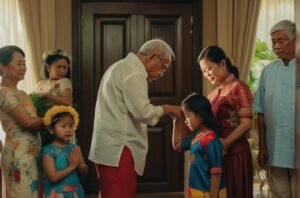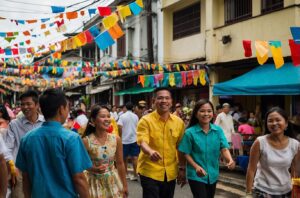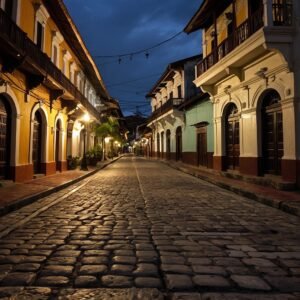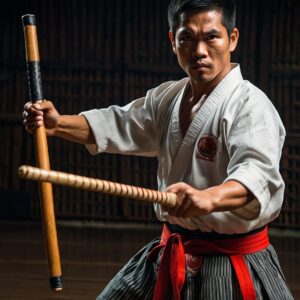
Filipino Hospitality and Warmth: A Cultural Hallmark
The Philippines, an archipelagic nation in Southeast Asia, is renowned for its stunning beaches, diverse ecosystems, and rich cultural heritage. However, one of the country’s most distinctive features is the warmth and hospitality of its people. This characteristic has become a source of national pride and a significant factor in the country’s tourism industry. The […]
Read More
Christmas in the Philippines: Traditions and Unique Practices
The Philippines, an archipelagic nation in Southeast Asia, is renowned for its vibrant culture and deep-rooted traditions. Among these, the celebration of Christmas stands out as a particularly significant and joyous occasion. Often referred to as having the longest Christmas season in the world, the Philippines begins its festivities as early as September and continues […]
Read More
Bayanihan: The Filipino Value of Cooperation and Community Spirit
Bayanihan, a cornerstone of Filipino culture, embodies the spirit of communal unity and cooperation that has been deeply ingrained in the Philippine society for generations. This cultural value goes beyond mere neighborly assistance; it represents a profound commitment to collective well-being and mutual support. Rooted in the Filipino word “bayan,” which translates to “nation,” “town,” […]
Read More
Mano Po: A Gesture of Respect in Filipino Culture
The Philippines, an archipelagic nation in Southeast Asia, boasts a rich tapestry of cultural traditions that have endured for generations. Among these time-honored customs, the practice of “mano po” stands out as a quintessential expression of Filipino values and social etiquette. This gesture, deeply ingrained in the fabric of Filipino society, serves as a bridge […]
Read More
Harana: The Traditional Filipino Practice of Serenading
Harana, a time-honored Filipino courtship tradition, has played a significant role in shaping the romantic landscape of the Philippines for centuries. This enchanting practice, deeply rooted in Filipino culture, involves a man serenading a woman with heartfelt songs, typically accompanied by a guitar, beneath her window or balcony. The custom of harana, which literally translates […]
Read More
Fiesta: The Filipino Tradition of Community Celebration
The Philippines, an archipelagic nation in Southeast Asia, is renowned for its vibrant culture and warm hospitality. At the core of Filipino social life lies a cherished tradition that embodies the spirit of community and celebration: the fiesta. Fiestas are grand, colorful events that bring together entire towns, cities, and even regions to commemorate patron […]
Read More
Vigan: A UNESCO World Heritage Site and Spanish Colonial Town
Nestled in the northwestern coast of Luzon, Philippines, lies the historic city of Vigan, a testament to the country’s rich colonial past and a living museum of Spanish-era architecture and culture. Recognized as a UNESCO World Heritage Site in 1999, Vigan stands as one of the best-preserved examples of a planned Spanish colonial town in […]
Read More
Arnis: The National Martial Art and Sport of the Philippines
Arnis, also known as Kali or Eskrima, is the national martial art and sport of the Philippines. This ancient fighting system has a rich history dating back centuries and has played a significant role in shaping Filipino culture and identity. Arnis is characterized by its use of sticks, blades, and empty-hand techniques, making it a […]
Read More
Baybayin: The Ancient Filipino Writing System
Baybayin, also known as Alibata, is an ancient writing system indigenous to the Philippines. This pre-colonial script was widely used in Luzon and other parts of the Philippines prior to the arrival of Spanish colonizers in the 16th century. Baybayin is a member of the Brahmic family of scripts, which includes many writing systems used […]
Read More
Traditional Filipino Dances: Tinikling, Singkil, and More
The Philippines, an archipelagic nation in Southeast Asia, boasts a rich tapestry of cultural heritage, with traditional dances serving as a vibrant thread in this intricate weave. These dances, passed down through generations, offer a captivating glimpse into the country’s history, values, and diverse regional influences. From the rhythmic clapping of bamboo poles in Tinikling […]
Read More